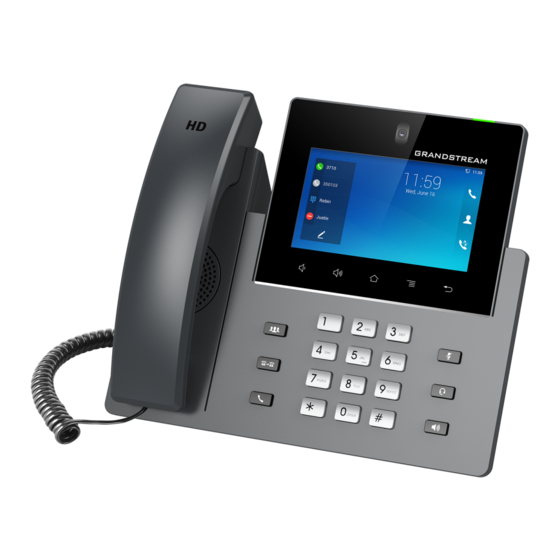
Grandstream Networks GXV3350 Configuration Manual
Hide thumbs
Also See for GXV3350:
- User manual (144 pages) ,
- Administration manual (104 pages) ,
- Quick installation manual (35 pages)
Summary of Contents for Grandstream Networks GXV3350
-
Page 1: Table Of Contents
Home PBXware SERVERware TELCOware SIPmon SIPProt Desktop & Mobile UADs Appliances From Bicom Systems Wiki Contents 1 Introduction 2 Requirements 2.1 Identifying Phone Model 2.2 Phone Firmware 2.3 DHCP Server 2.4 PBXware Version 3 Installation 3.1 Power Adapter 3.2 Power over Ethernet (PoE) 3.3 Find the Phone's IP Address 3.4 Reset to Factory Settings 4 Registering Phone... -
Page 2: Requirements
This Configuration Guide is written as a general guide on how to configure the Grandstream phone model GXV3350 to work with PBXware 5.3.6. Requirements Identifying Phone Model To start and successfully complete registration of your Grandstream phone you need to know which phone model to set up. -
Page 3: Dhcp Server
note that the factory default login details are as follows: username is admin and password is admin. You will be prompted to change the default password. DHCP Server Fully configured and operational DHCP server. PBXware Version PBXware version 5.3.6 In order to find out the PBXware version: Log in to PBXware Navigate to Settings: About. -
Page 4: Find The Phone's Ip Address
the in-line power router or switch. NOTE: If you are using Power over Ethernet (PoE), you don't need to connect the AC adapter. Make sure that the Ethernet cable and router or switch is Power over Ethernet (PoE) compliant. Find the Phone's IP Address Find out your Grandstream phone's IP Address. - Page 5 phone. The following topics are covered: UAD settings Creating Extension Registering Phone UAD Settings UAD settings Log in to the PBXware's web administration interface Open a new browser window and enter the IP address in order to access the PBXware web administration login screen.
- Page 6 Local is for all Extensions registered on the LAN and Remote is for all Extensions registered from remote networks, WAN, Internet etc. Click the Next step button. Extension Values Enter values into the required field text boxes. REQUIRED FIELDS: Name Enter a name for the Extension being created.
-
Page 7: Auto Provisioning
Account Name The PBXware extension number. Example: 1003 Sip Server Enter the Hostname or IP Address of the PBXware. - Example of a Hostname: voip.bicomsystems.com - Example of an IP Address: 192.168.1.10 SIP User ID The PBXware Extension number. Example: 1003 Authenticate Password The Secret of the Extension as received in the e-mail associated with this extension. - Page 8 Log in to the PBXware's web administration interface. Open a new browser window and enter the IP address in order to access the PBXware web administration login screen. Example: http://192.168.1.10. Log in to PBXware with your e-mail address and password. UAD Settings Navigate to Settings: UAD.
- Page 9 Enter the e-mail address associated with this Extension. This e-mail address will receive all system notification messages. Example: john.smith@bicomsystems.com Auto Provisioning Set to Yes. MAC Address Enter the Grandstream phone's MAC address. Example: 000B82123456. The MAC address can be found at the back of the phone. Click the Save button.
- Page 10 Make sure that the checkbox Use Grandstream GAPS is not marked. Choose what server type you intend to use in the Config Update via field: HTTP, HTTPS, and Trivial FTP. NOTE: Our recommendation is to use HTTP. If the Server Type is HTTP or HTTPS, enter the Hostname or IP Address followed by /prov in the Config Server Path field.
- Page 11 Example of a Hostname: voip.bicomsystems.com Example of an IP Address: 192.168.1.10 Click the Save button. NOTE: You will need to wait a couple of seconds for the configuration to be updated. Do not power off your phone. The Auto provisioning process will start during the phone's reboot process, the phone will pick up an appropriate configuration file from PBXware.












